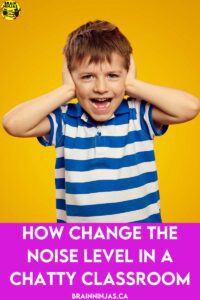
Do you ever have days where you just want to put in earplugs? Do you smile at the serenity of sitting in your quiet car all the way home? Is your noise level burnt out when you get home and wish for the sound of silence?
As an introvert, I always felt my classrooms growing up catered to noisy kids. I was so lucky that I often got sent to work in the library or other rooms with smaller groups. Some of that was a reward for having my work done, but I know Miss Rodney could see I was drowning in the noisy chaos.
It makes me sensitive to the students who probably feel the same way. Come learn some of the ways I’ve tried to manage the chatter in my upper elementary classrooms over the years.
Talk About Noise Levels in the Community

Explain that managing your noise level is an important social skill. There are many places where you are expected to be quiet. Make a list with your students (e.g. in a movie theatre, at a medical appointment, church, etc.). Other places are allowed to be noisier (e.g. a sports game, outside, etc.).
Explain that schools also have different noise levels. Talk about how there are differences in the library, in the gym, in the halls, outside, in the music room, in the office, or anywhere else in your school.
Set Clear Expectations About Noise Levels
Explicitly communicate your expectations for different noise levels and classroom behaviour from the very beginning of the school year. Keep this simple. Model and practice with students. It is shocking how many students don’t even know their own noise level.
Have a class discussion about different noise levels. For example, the noise level at a hockey game is okay outside when students are playing, but it is not okay inside the classroom. When students are working in a group, only the members of the group should be able to hear what the other groups are saying. If you are whispering to someone, only the person you are whispering to should be able to hear you.
Explain that there are times to talk and times when it’s not appropriate. Give the reasons why whenever possible. For example, when your students are walking from your classroom to the gym. If they talk, they’ll disrupt other classes. No one wants that.
Hold a class discussion about the importance of quiet work time and respectful listening during instruction. Do a survey about who likes noise or quiet during different types of work. For example, during a test, it should be completely quiet. During independent work, it should be mostly quiet unless someone is moving or has a question. Be clear, model it, and talk about why.
Model and Practice
Do not expect students to know how to control their noise level without practicing. Use a simple activity where students will get to chat and then practice keeping the noise levels controlled or stopping when you give a cue.
A simple activity is these Would You Rather? cards. They are available in our Resource Library, but we can send them directly to your inbox when you sign up for our email list.
We also have Back-to-School Discussion Cards. They can be used any time of year to refresh your noise levels (or just for fun). Find the Back-to-School Discussion Cards in our TpT Store ($USD) or our BN Shop ($CAN).
Use Non-Verbal Cues
Establish specific signals or cues (e.g., raising a hand, using a quiet signal) to indicate when it’s time to quiet down and focus. If you use vocal cues, you are likely adding to the noise.
Some of the quiet signals we use include turning off the lights (students stop and look at the light switch), standing at the front of the class (students stop and make eye contact), or raising a hand (students stop and raise their hands).
Teach Active Listening Techniques

Teach students active listening skills to help them become more attentive and focused during instruction. Before sending students to work independently, make sure they know exactly what to do during and after the activity. Model active listening behaviours, such as making eye contact with the speaker, nodding in acknowledgment, and paraphrasing what was said.
Incorporate listening (and talking) activities and exercises into daily routines, such as “turn and talk” discussions or partner reading activities. Manage the noise level while they are talking.
Use Visual Reminders
Employ visual cues and reminders to help students monitor their noise levels and self-regulate their behaviour. Bouncy Balls is a free visual (however some students are motivated to make more noise just to see it move). If you’re worried about microphones in the classroom you can use a decibel reader. Anything about 60dB is considered too loud for learning. 100dB or louder can damage hearing.
Display the current acceptable amount of noise that is allowed. Once you’ve established your classroom norms, start each activity by explaining which noise level is acceptable.
Your seating plan is another visual cue. Place students in positions where they can easily separate or push desks together depending on the activity or acceptable noise level. Chatty kids will talk to anyone, so it doesn’t matter where you put them. Teach other kids not to respond.
Implement Behaviour Management Strategies

Establish a hierarchy of consequences for noise violations, starting with gentle reminders and escalating to more serious consequences if necessary. If the class is too loud, stop the activity, remind and reset. Provide positive reinforcement and praise for students who demonstrate appropriate noise levels. Don’t forget to match the noise level with your own voice. Nothing is worse in a quiet classroom than a loud teacher who sets them all off.
Be consistent. Don’t make promises or threats without following through.
Build In Brain Breaks
Recognize that students may become restless or chatty during extended periods of focused work. Incorporate regular brain breaks or movement activities into the daily schedule to help students release excess energy and refocus their attention.
Train students. At the beginning of the year, build stamina by slowly increasing the length of time students work independently or quietly. Keep score and see if they can continually beat it. Be realistic. In all our years, our top score was 48 minutes with a Grade 5 class. Their brains aren’t designed to stay focused any longer, so break up the time between quiet with other noise levels.
When you’re in the gym, explain the difference between noise and screaming. Students do not need to scream while in the gym (something happens to girls in Grades 4 and 5 that they test this theory), so teach them that screaming is reserved for dying or significant fear or injury.
Use mindfulness or relaxation techniques, such as deep breathing exercises or guided visualization, to help students calm their minds and bodies.
Teach Group Work Strategies and Noise Levels
Structure group work activities that require active participation and contribution from all group members, encouraging students to communicate and collaborate effectively. Rotate group roles or responsibilities to ensure that each student has a chance to contribute and stay engaged in the task at hand.
Teach students how to work together. This can help reduce the amount of noise. Our post, How to Teach Students to Work in Groups, might be helpful.
One strategy we use is putting the noisy kids in the same group. This means we usually have four groups on task and working quietly and one group we have to sit close to and help manage (but it means we’re not spread so thin trying to manage all the groups).
Plan and Prepare

The easiest way to lose your class to chatter is by not having your lesson ready or materials prepared. Just keeping yourself organized can be an easy way to minimize the time students chat instead.
Keep your transitions efficient so students don’t get lost in chatter. Use the brain breaks during the transitions so students can get the talking out before they are expected to focus on the next activity.
Part of this is about being realistic. You can’t put students in groups and then expect silence. Instead, switch up activities that offer different amounts of noise throughout your plans.
Be Positive
Give positive feedback to the students who manage their noise level in each situation. A simple thank you is all some students need.
Don’t forget to check in with your introverts. They are usually the best indication if a classroom is too noisy. For more strategies to help your introverts learn, try our post 3 Ways to Support Introverts in Your Classroom.
Don’t Give Up Your Comfortable Noise Level
You are allowed to determine the noise level in your classroom as you are there day in and day out. Students should have the chance to chat, but those breaks are built into the day and depend on the students in your room.
You might also like How to Make Students Listen Without Yelling.
Be patient and keep trying. Your students will come around. Do you have any strategies for chatty classrooms? We’d love to hear about them in the comments below.







